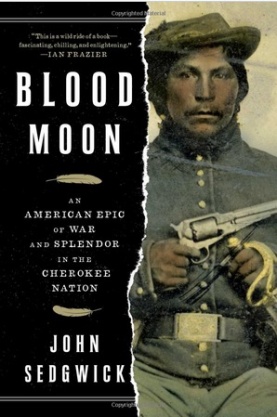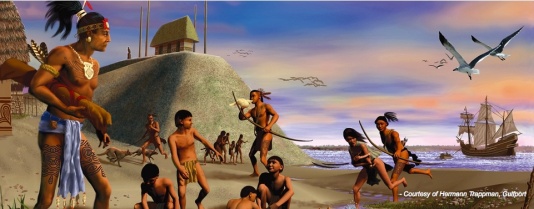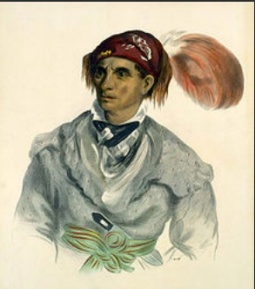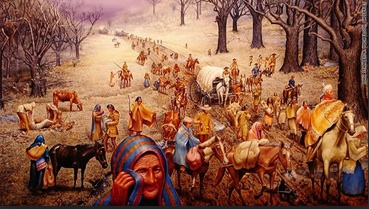My good friend, Gene Cohn, recently presented me with a first edition copy of the newly released Blood Moon, by John Sedgwick. Gene knows me as a man fascinated with Native American history. Generous, and intuitive, Gene didn’t know what an arduous task he’d presented me with. But, I think he guessed he would be re-stoking the fires of a life-long obsession, one that has been inspiring and dreadful, in equal measure.
The majority of my self-education on Native American history has focused on the Plains Tribes. Reading Dee Brown’s Bury My Heart at Wounded Knee in college was a launching point. Black Elk Speaks was, for me, a bible of cultural understanding of the Oceti Sakowin, the people of ‘The Seven Council Fires’, often referred to as ‘The Great Sioux Nation.’ Dakota White, my own book of reckoning, stemmed from my birth on a South Dakota homestead, land that just a handful of years earlier was the hunting ground of the Nakota, known among the Oceti Sakowin as ‘Keepers of the Sacred Pipestone.’ (I fed my white guilt with a host of other great books like – examples listed at the end*.)
Two four-foot stacks of books about and by Native Americans dominates one corner of my home library while dozens of novels by great Native American writers like Louise Erdrich, James Welch and Sherman Alexie occupy large swaths of my more-or-less alphabetized shelves. Each author opened my mind to their tribal cultures, Welch of the Blackfeet, Erdrich of the Turtle Mountain Band of Chippewa and Alexie of the Spokane-Coeur D’Alene tribe.
 But, regardless of the tribe, of the author, whether history, biography or fiction, over and over again the same theme prevails. Whites ignored Native wisdom, deceived them and lied to them at every turn and perpetrated every imaginable form of genocide on them. When extermination and relocation failed to squelch their spirits, we tried to rid them and rob them of their own cultures. It is only by their unique earth-inspired strength that they still live among us today. It’s impossible not to want to emulate such noble people and to welcome their insight into life on this planet, wisdom that we continue to ignore.
But, regardless of the tribe, of the author, whether history, biography or fiction, over and over again the same theme prevails. Whites ignored Native wisdom, deceived them and lied to them at every turn and perpetrated every imaginable form of genocide on them. When extermination and relocation failed to squelch their spirits, we tried to rid them and rob them of their own cultures. It is only by their unique earth-inspired strength that they still live among us today. It’s impossible not to want to emulate such noble people and to welcome their insight into life on this planet, wisdom that we continue to ignore.
Our treatment of Native Americans has always been symptomatic of our unwillingness to grow and to learn. Just when it seems we might evolve past our Christian-backed colonialist policies, we betray our progress with more oppression and less tolerance, succumbing again to greed and heedless expansion. Our history with the Cherokee is a powerful chapter of this seemingly inevitable pattern.
The Cherokee struggle with white invaders started earlier than that of the western tribes. The Cherokee got their first taste of European cruelty in 1539 when Hernando de Soto invaded their territory brandishing guns, wearing shiny pointed helmets and herding a hundred tamemes, enslaved Natives from Florida.
Disappointed that they didn’t find gold they’d come in search of, DeSoto and his Spanish troops only stayed long enough to instill a bad impression, of a cruel, ghostly white people. Though they knew that these whites might continue to arrive from the east and the south, they had little reason to be worried. Confident in their own prowess as warriors and unaware of the overwhelming numbers that would someday invade, they were not fearful. Nor did they demonstrate any huge concern over the first English settlers to arrive in their territory in 1657. The Cherokee held vast territories rich in resources and enjoyed a rich culture in which all were considered equal – their language had no pronouns to distinguish male or female and the chiefs of tribal councils were chosen by the women. When they went to war they were fierce and unrelenting. When at peace they were accommodating and known for their hospitality. And, they were quite adaptive, trading with whites once they understood their greed, even selling them slaves, Indians they’d captured from other tribes.
 They continued to adapt. Chiefs often wore a mix of European coats, shirts and cravats accented by turbans and feathers.
They continued to adapt. Chiefs often wore a mix of European coats, shirts and cravats accented by turbans and feathers.
The whites’ writing fascinated them. One especially fascinated with what they called ‘talking leaves’ was a humble, enterprising Cherokee named Sequoyah who developed an 85-character Cherokee alphabet. Because it was fairly easy to learn, thousands of tribal members quickly became literate. This lead to a written Cherokee Constitution, modeled after the U.S. Constitution and a widely circulated Cherokee newspaper. They were organized and fluent in their adaptation. When Jefferson, who met several times with Cherokee leaders, encouraged them to assimilate and become farmers, they took up farming, some becoming rich, overseeing vast plantations. But, for all their adaptation and their ability to wage war, they, like all Native American tribes, had no defense against white diseases.
Because it was fairly easy to learn, thousands of tribal members quickly became literate. This lead to a written Cherokee Constitution, modeled after the U.S. Constitution and a widely circulated Cherokee newspaper. They were organized and fluent in their adaptation. When Jefferson, who met several times with Cherokee leaders, encouraged them to assimilate and become farmers, they took up farming, some becoming rich, overseeing vast plantations. But, for all their adaptation and their ability to wage war, they, like all Native American tribes, had no defense against white diseases.
As Sedgwick points out in Blood Moon, “the whites brought with them toxic contagion, which had been brewed for centuries in congested European cities and for which the Cherokee . . . had developed no defenses: among them dysentery, typhus, influenza, scarlet fever, diphtheria, whooping cough, mumps, yellow fever and even bubonic plagues . . . but by far the greatest and most hideous threat was smallpox.” In the 1670s the Cherokee population was estimated at 50,000, by the mid 1700s their population was half that.
And yet they fought on, negotiating treaties to save the lands they cherished, selling other tracts to fund their ongoing assimilation, building houses, mills and ferry systems. They were no less enterprising in war, siding originally with the British against American Revolutionaries, and taking funding from the Spanish in Florida, then fighting with the Americans against enemy tribes like the Creeks. Yet their collaborations were usually betrayed. They fought with General Andrew Jackson, helping him wipe out the Red Stick tribe in Alabama in 1813, only to have President Jackson call for the Cherokee – and all the ‘Five Civilized Tribes’ — to be forced to move west of the Mississippi in the 1830s.
But, if anything can be more heartbreaking than the plight of the Cherokee, it is the story that Blood Moon tells of the Cherokee’s deadly internal struggles at the hands of two opposing chiefs, The Ridge, or Major Ridge as he was known, and John Ross, a mixed-blood Cherokee who somehow commanded fierce loyalty from the majority full-blood tribal members. Friends and allies at first, working together to further the Cherokee Constitution and tribal adaptation to farming, they soon split, their mutual animosity fomenting into a family-backed feud that lasted more than fifty years. When Jackson pushed for Cherokee migration west, The Ridge agreed it was for the best, but John Ross convinced over half the tribe to stay put in the east.  After the final full forced migration in 1836 known as the ‘Trail of Tears’ they continued their bloody feud while settling in Arkansas and present-day Oklahoma — family assassinations, burning each others houses and finally taking up opposite sides in the Civil War. So fierce were Cherokee Confederates and those siding with the North, that by the end of the Civil War the Cherokee had lost another 25% of their population.
After the final full forced migration in 1836 known as the ‘Trail of Tears’ they continued their bloody feud while settling in Arkansas and present-day Oklahoma — family assassinations, burning each others houses and finally taking up opposite sides in the Civil War. So fierce were Cherokee Confederates and those siding with the North, that by the end of the Civil War the Cherokee had lost another 25% of their population.
Although faithful to their tribes, or at least to their factions of the tribe, Ross and Ridge represent leaders too quick to assimilate, too attracted to political power and, especially in the case of John Ross, too infected with white man’s greed. Whatever their motivations, they and their people were – like all the First People of the Americas – victims of white acculturation.
From 1906 to 1975, Cherokee tribal government was essentially defunct. New, slightly more enlightened policies by the U.S. Government, have resulted in a tribal resurgence. Today Cherokee tribal enrollment lists over 300,000 members and they operate with a new constitution, strong leadership and have significant tribal holdings. Theirs had been a long, ugly struggle against white oppression, but today their tribal website proudly proclaims:
The heritage of the Cherokee Nation is evident today in the survival of our traditional arts ranging from basket making to traditional clothing such as ribbon shirts and tear dresses. That heritage is alive and well today and is displayed in the way we work, the way we live and the way we play.
The result of immersing myself in Native history is that I frequently want to yell, “Stop! Stop! Stop!” I can’t help but blame my oppressive ancestors and wish that they were more enlightened and admonish them for not aligning their behavior with the Christian truths they espoused. After the Cherokee translated the Bible into their own language, a missionary convinced a famous Cherokee chief named Drowning Bear to let him read the Book of Matthew to him. After listening quietly, Drowning Bear said, “It seems to be a good book. Strange that the white people are not better after having it so long.”
White America failed to live by its own Christian ideals (as well as its Constitutional proclamations) and, in doing so, missed the opportunity to learn and assimilate theirs. U.S. history is often a tawdry tale of Americans doing this over and over again, and not just in its relationship to Natives.
The Cherokee sought peace, were willing to assimilate, but instead of supporting them on that path the American people choose Andrew Jackson, ‘Old Hickory, the Indian Killer,’ as president. They knew that he would keep pushing the Cherokee westward, oppressing them until they relented. They elected him for that very reason. Just as Americans of the early 21st Century keep choosing the familiar, greedy, me-me-me path – that of conservatives dressed up as true patriots.
In 2000 we (narrowly / questionably) rejected Al Gore, who was at the forefront of confronting Climate Change. We ended up with George W. Bush who led us into a magnificently wasteful war in the Iraq, promoting and protecting the very oil consumption that is helping fuck up our planet’s atmosphere. Finally, in 2008 we elected Obama, a progressive who led us out of financial catastrophe, toward a more humane health care system, who supported Tribal lands and governments and focused on climate change by enacting strong environmental policies. But, apparently Obama took us too far, too fast, his enlightened policies rejected by enough voters to result in Trump.
Trump is Jackson, America wanting to turn back to our selfish, protective, delusional sense of ‘manifest destiny’ – increase military, instill fear and hate, worship wealth, discount the poor, disenfranchise minorities and disrespect women. ‘Make America Great Again’ translates into ‘Make America Mean Again.’ When I read Native American history, I’m looking into a mirror, reflecting back the lessons we have still not learned.
∞∞∞∞∞∞∞∞∞∞∞∞∞∞
A few NOTES:
*In comparison to the Cherokee, the Lakota (Oceti Sakowin) didn’t encounter many whites other than a few French trappers until the Lewis & Clark expedition in 1804 – by then the Cherokee had been dealing with white encroachment for a century and half.
Some of the fundamental books that opened my eyes:
- Crazy Horse by Mari Sandoz
- Empire of the Summer Moon by S.C. Gwynne
- Lakota Woman by Mary Crow Dog
- On the Rez by Ian Frazier
- American Indians: Answers to Today’s Questions by Jack Utter
- Cogewea by Mourning Dove (Hum-ishu-ma)
- Touch The Earth – a Self-Portrait of Indian Existence by T.C. McLuhan
- The Indians Today, a 1926 work by Flora Warren Seymour, the first female Indian Commissioner
- The History of Indian Policy, a 1975 summary from Bureau of Indian Affairs, edited by S. Lyman Tyler
I don’t really agree with how progressive Obama was. He was also a supporter of the racial status quo, making him no better than the others really. If this is of any interest, I can recommend “How to be less stupid about race.” It’s very enlightening!
LikeLike
I nearly got into a difficult conversation with my companions the other day when talking about Christian beliefs and the lack of applying their principles to other races….and that all started out from talking about the ‘hosts’ containing gluten for people with allergies.
I know what you mean in that paragraph yelling Stop! 🙂
LikeLike